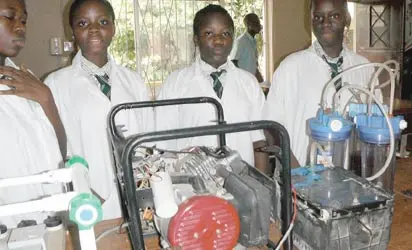A generator that can generate six hours of electricity from one litre of urine was created by four adolescent girls in Nigeria.
The innovation was on show by the girls, Duro-Aina Adebola, Akindele Abiola, Faleke Oluwatoyin, and Bello Eniola, at the annual Maker Faire Africa in Lagos.
The ladies claimed that although the concept of utilising urine as fuel was not new, Adeola, Abiola, Oluwatoyin, and Eniola came up with a workable solution that many houses could employ.
This was revealed by RusselSmith, a well-known supplier of Integrated Energy Solutions. Adebola, a 14-year-old, added that she got the idea to use urine to make electricity after reading about a family of five that perished.
She claimed that while they were sleeping, the family members breathed in fumes from their generator, which caused them to become poisoned with carbon monoxide and die.
She expressed concern about the incident and considered ways to help stop it from happening again, coming to the conclusion that the best course of action was to switch to a power source that doesn’t emit carbon monoxide.
Adebola said she discussed the concept with her three friends: Abiola, Oluwatoyin, who are both 14 years old, and Eniola, who is 15.
The four friends took on the moniker “Fantastic Four” and set out to find a solution, which eventually proved to be successful and well recognised.
The Fantastic Four claimed that after discussing their hypothesis with Olaide Lawal, their physics teacher, they received encouragement that the signal might be real.
Inspired by this, the teenage girls started experimenting with potential energy-producing elements other than carbon. They claimed to have realised that hydrogen powers rocket engines.
The girls explained that the idea behind their innovation was that water would be the final output if hydrogen served as the generator’s raw material. The group reported that they ran into trouble after experimenting with water.
The researchers said that they arrived at the conclusion that electrolysing water would result in a 1.25 volt loss at every cycle due to the minimal hydrogen production in water.
Adebola claimed to have advised the group to test a free material that can produce the energy required to power household appliances. At this moment, the team started to think about utilising urine as a raw material source.
According to Adebola, their first device was based around an electrolytic cell made out of an old vehicle battery. In addition, the system contained pipelines, filters, and an empty gas storage tank.
“We then reconfigured our petrol-based generator and carried out our first experiment – and then we faced another huge challenge as the cell exploded,” the girls said.
“We kept on checking our process and setup until Mr. Lawal pointed out our error: The hydrogen-oxygen gas mixture was returning to the cell. We then inserted one-way valves into the pipes to ensure a one-directional flow of the gas mixture, and it worked,” they added.
The Fantastic Four claimed that when people saw their creation in public for the first time, they lost optimism that it would succeed. Nevertheless, they persisted and made adjustments. When they displayed their innovation at the Maker Faire Africa in 2012 once more, they attracted national notice.
The Fantastic Four have won national and international recognition for their urine-powered generators since the presentation. The Lagos State government has stated that it would like to provide funding for the invention’s large-scale development so that homes can use it.
The teenage girls thanked Doregos Private Academy, their school, for providing the funds, the means of transportation, and the moral support that allowed them to follow their dreams.
VANGUARD


